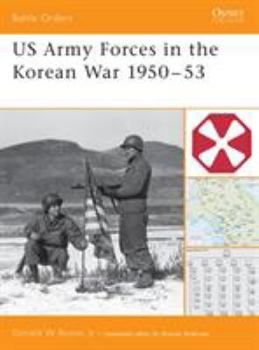US Army Forces in the Korean War 1950 53
(Book #11 in the Osprey Battle Orders Series)
When North Korea attacked the South on June 25, 1950, United States forces in East Asia were under the command of General Douglas MacArthur, whose largest ground force was Eighth US Army. This army... This description may be from another edition of this product.
Format:Paperback
Language:English
ISBN:1841766216
ISBN13:9781841766218
Release Date:April 2005
Publisher:Osprey Publishing (UK)
Length:96 Pages
Weight:0.65 lbs.
Dimensions:0.3" x 7.2" x 9.9"
Customer Reviews
4 ratings
Review
Published by Thriftbooks.com User , 14 years ago
Purchased this book for a graduate history paper and was able to use the valuable information.
US ARMY FORCES IN THE KOREAN WAR 1950-53 (BATTLE ORDERS)
Published by Thriftbooks.com User , 17 years ago
ON TIME, AS DESCRIBED..WOULD DO BUSINESS AGAIN.,
US Army Forces in the Korean War 1950-53
Published by Thriftbooks.com User , 18 years ago
US Army Forces in the Korean War provides detailed descriptions of the Army's organization during the Korean conflict. The book has many charts and tables laying out unit's manning and equipment tables. The order of battle tables for all Army divisions that took part in the conflict alone are worth the price for the serious Korean War buff or veteran as they provide detailed lists and dates of service for assinged and attached units. In addition, the book gives an overview of the conflict, Army tactics, equipment and doctrine of the period. There are plenty of maps to orient the reader to the conflict, and the book is well illustrated with photographs. My only minor complaint is the small size of some of the photos. To its credit, the book covers not only combat units, but support and service support units are also described. This book has a ton of information on the US Army in the Korean War at an affordable price, you will not be disappointed.
A Good Adjunct to Other Sources, such as Clay Blair
Published by Thriftbooks.com User , 19 years ago
Retired US Army Colonel Donald W. Boose, Jr. provides an authoritative survey of the composition and doctrine of the US Army in the Korean War in Osprey's Battle Orders #11. Readers looking for detailed line and block charts of various US Army units in this period, as well as details on tables of organization and equipment, will be well satisfied with this volume. However, readers should note that the omission of US Marine, UN and ROK units (which were often attached to US units) renders this account a partial one. US Army Forces in the Korean War 1950-53 begins with introductory sections on the mission of US Army units in Korea, doctrine and training. In these sections, the author notes the gradual desegregation of the US Army in 1950-51 and the introduction of KATUSA augmentees. The heart of the volume lies in the 23-page section on unit organization, which details US units from 8th Army down to battalion level. Although Boose admits that he focuses on combat units at the expense of support units, some omissions probably required greater clarification. For example, Boose notes the Regimental Tank Company owned two medium trucks for mess and supply, but this clearly did not encompass fuel and ammunition resupply. This is no small issue. Even thirty years later, when my tank platoon in the 2nd Infantry Division in Korea was attached to an infantry unit, we had major problems getting fuel and ammunition since the infantry supply structure was not configured to support our requirements. This volume has eight 2-D maps: the Korean War. Phase 1 (delay and defense); Phase II (counteroffensive); Phase III (war of movement); Phase IV (static warfare); UN offensive operations, September-October 1950; 8th Army advances north, 1951; corps boundary shift, April 1952; Korea communications zone, 1952-53. The author also includes numerous line and block charts on units from army to battalion level. Other sections cover weapons, C3I and unit status (a thumb-nail history of all major units in Korea). There is a wealth of information in these pages. Although this volume is not designed to address the operational aspects of the war in much detail, I did have the sense that the author was soft-peddling the multitude of US setbacks in the war. The virtual destruction of the 24th Infantry Division in July-August 1950 (including the capture of its commander) get virtually no mention here. The 2nd Infantry Division's defeat in November 1950 - one of the greatest one-day losses in US military history - appears as a "setback." Further US defeats in early 1951 also are barely mentioned. Boose tends to ascribe early US problems to understrength units but there was a lot more to it than that, including poor air-ground cooperation at the start, unrealistic training and a condescending attitude toward the KPA (a mistake the US repeated by underestimating the Chinese troops). The fact is that the US Army was initially unprepared for a tough ground war in Korea and was o






